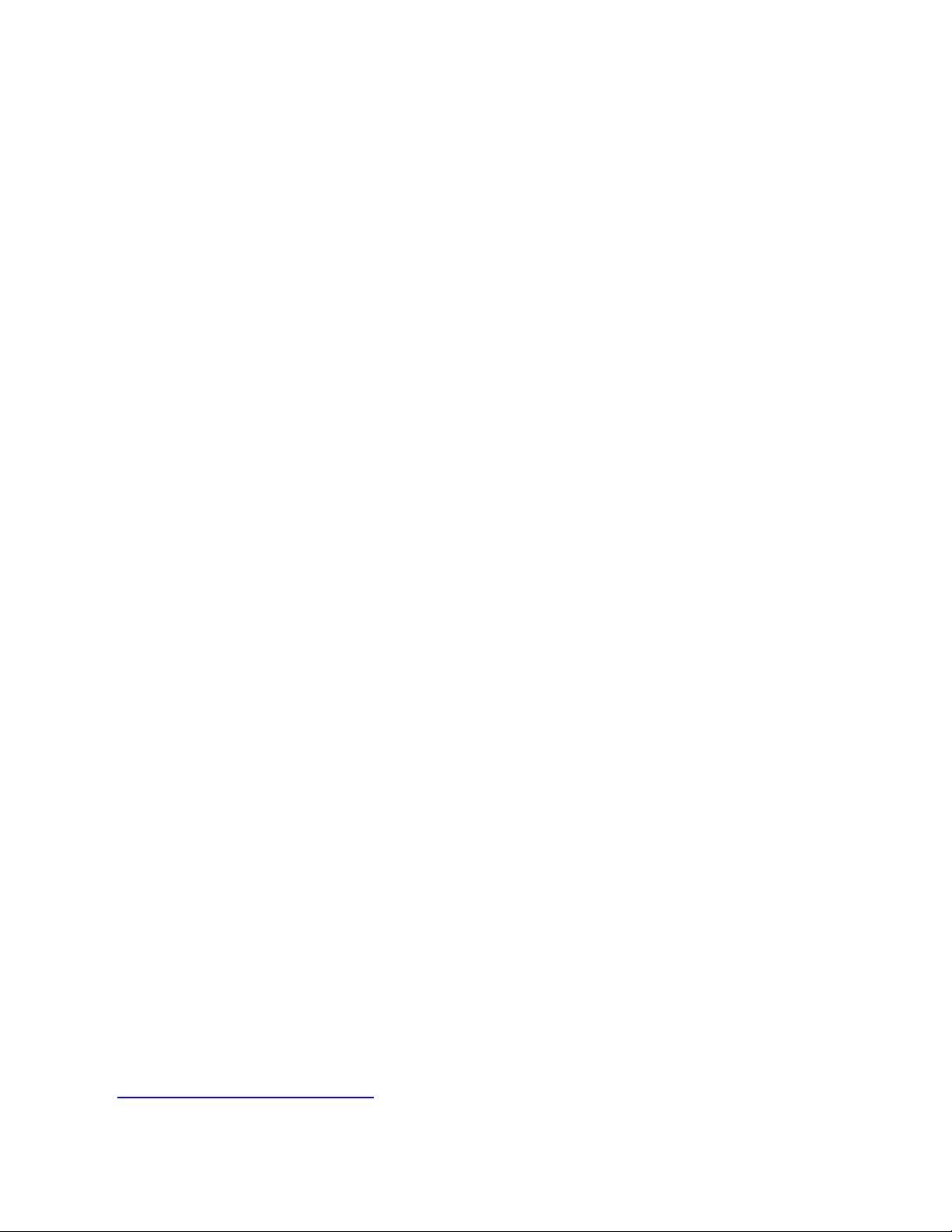
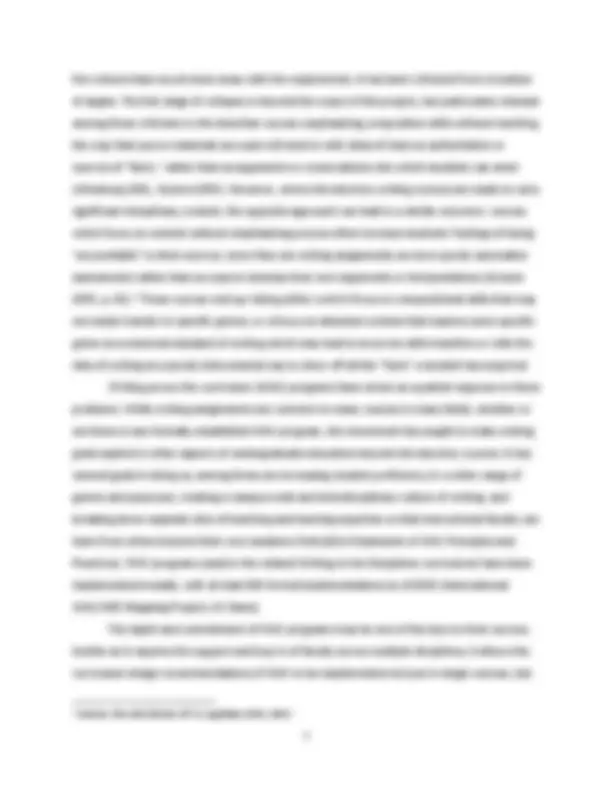
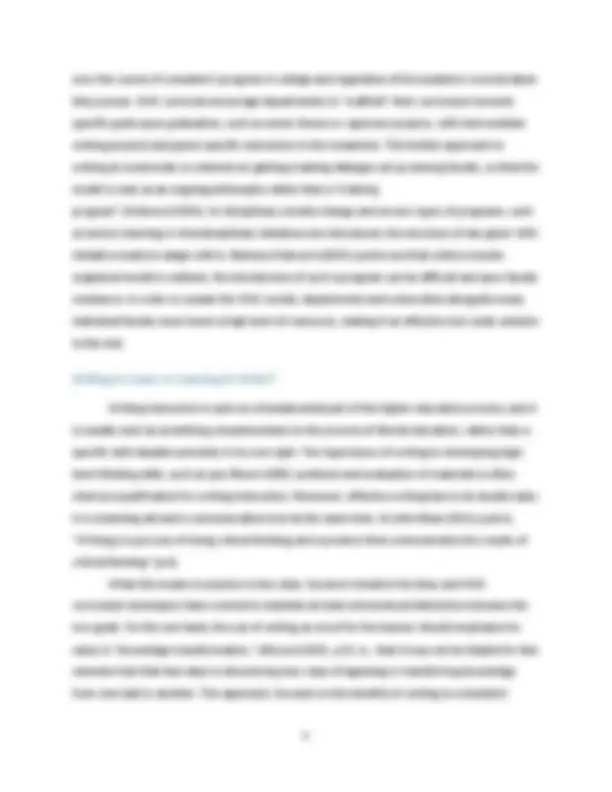
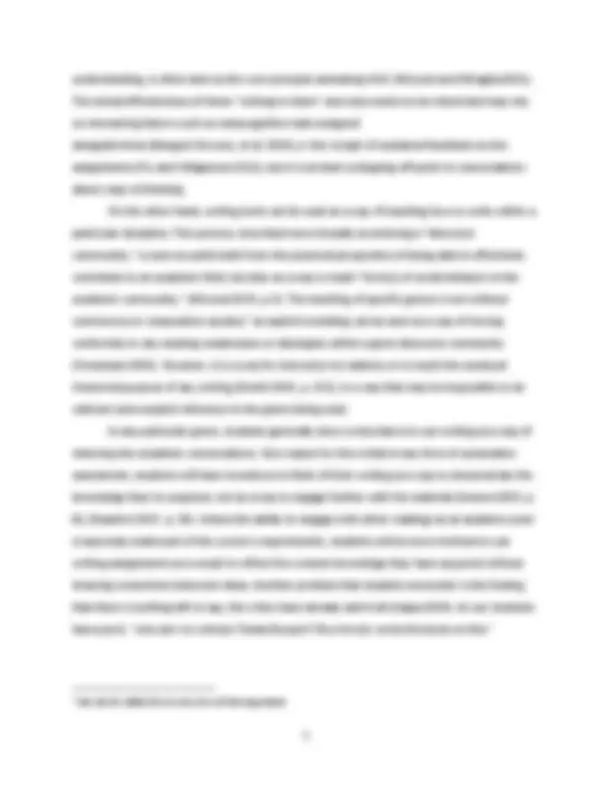
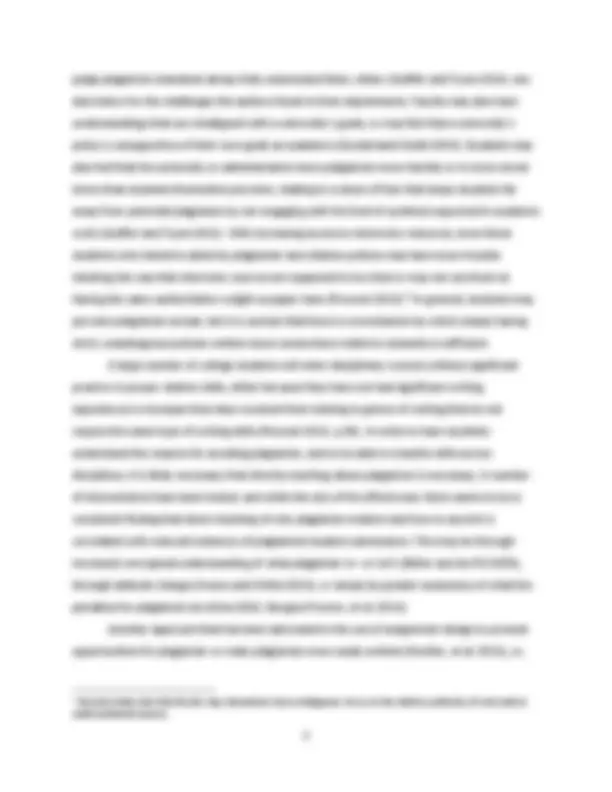
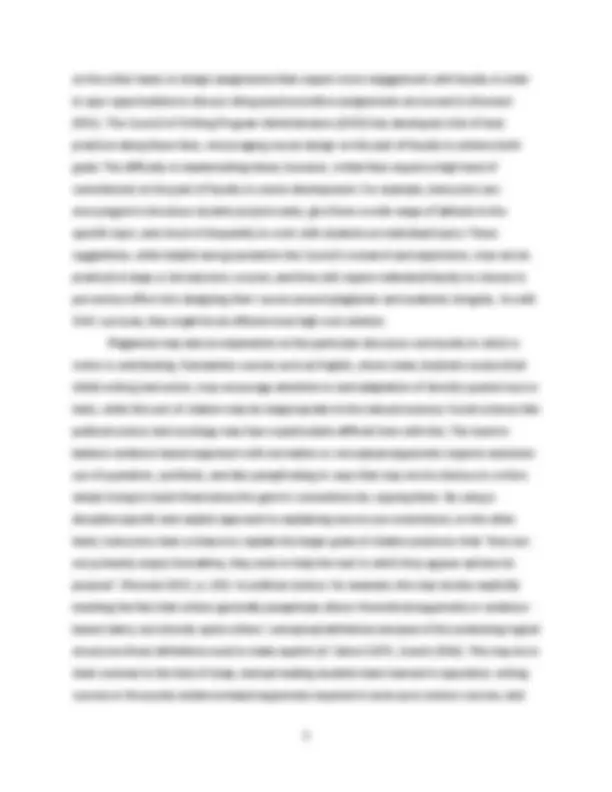
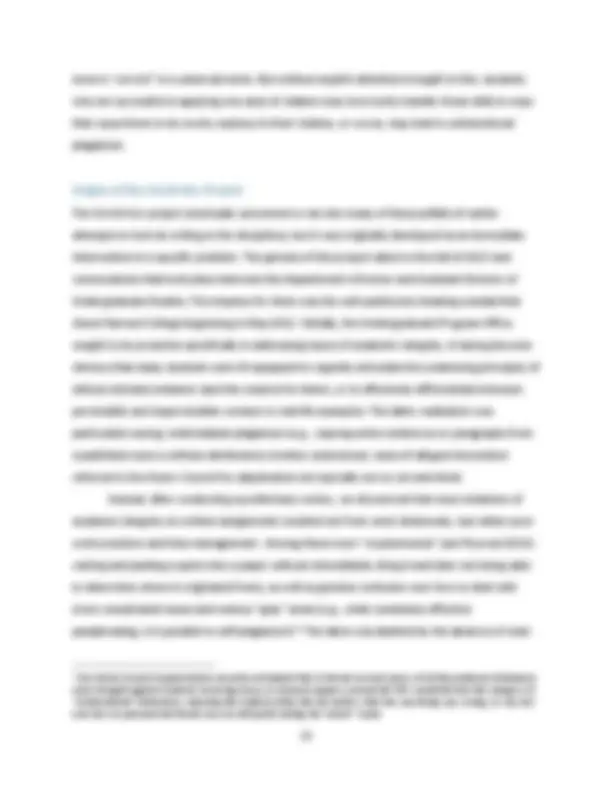
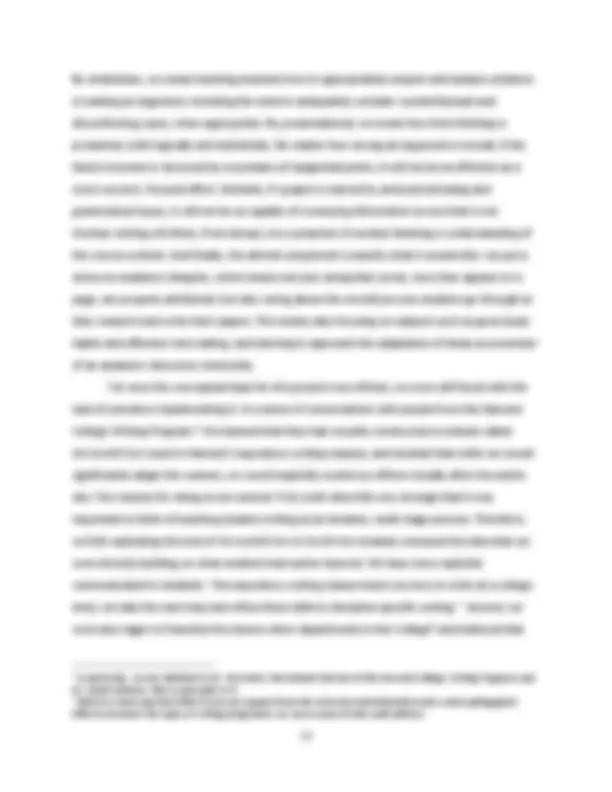
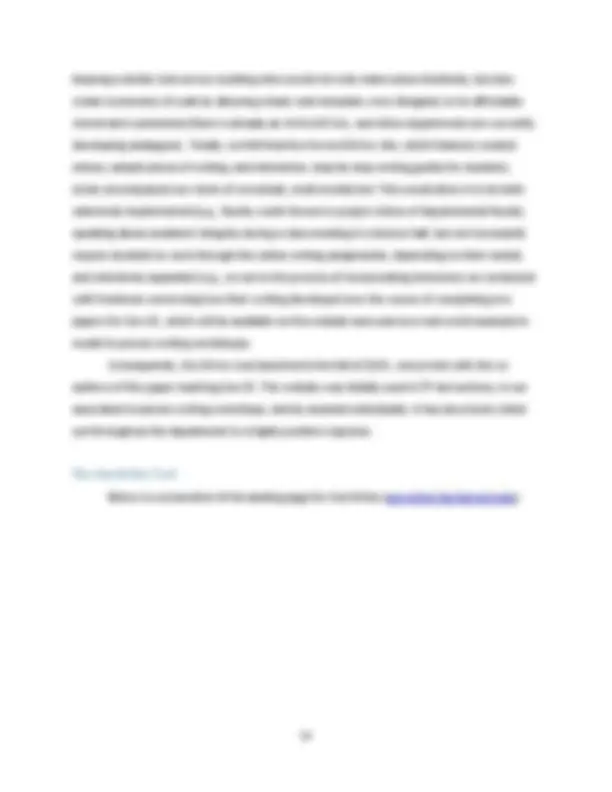
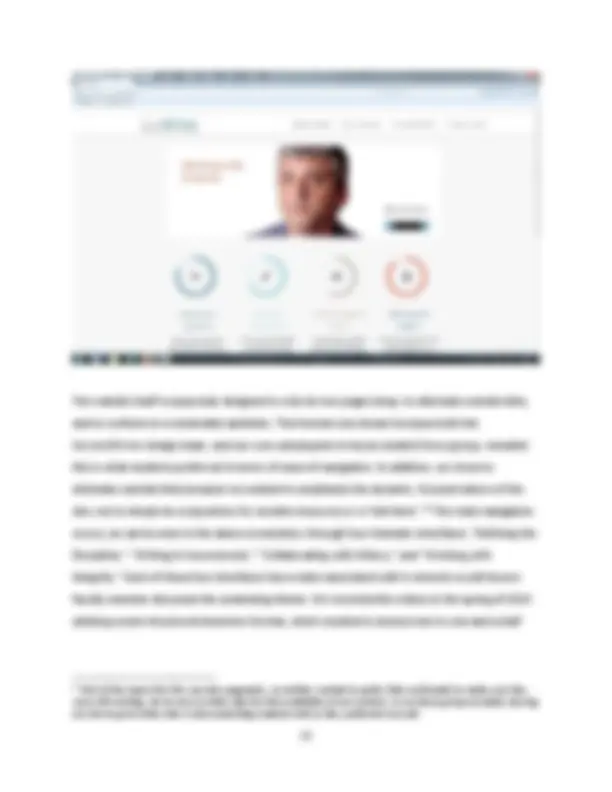
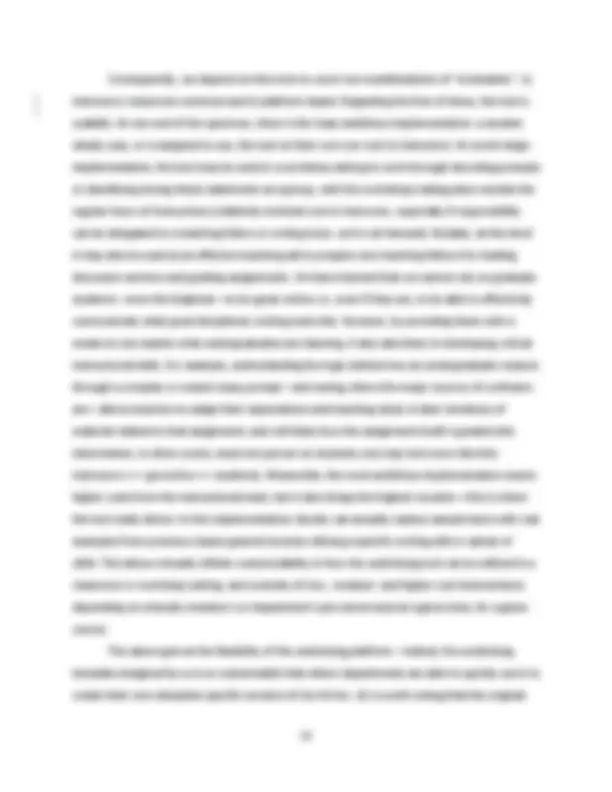
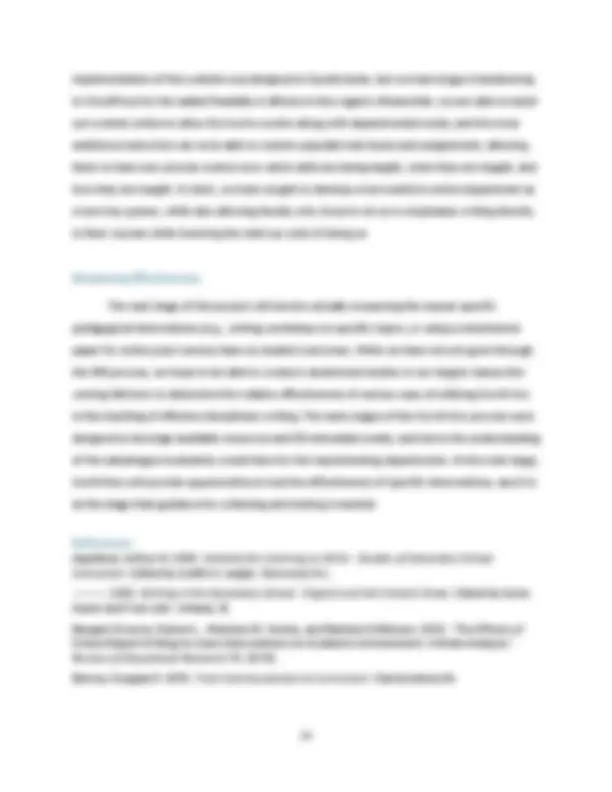
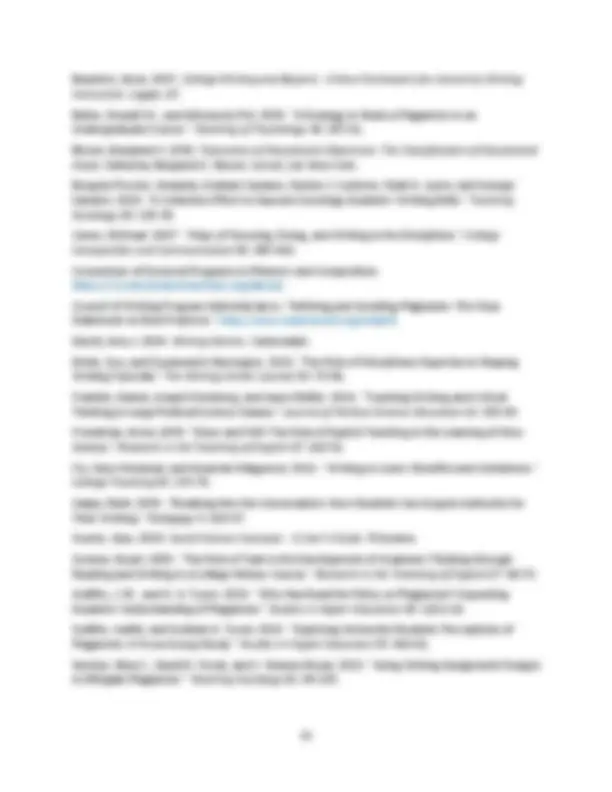
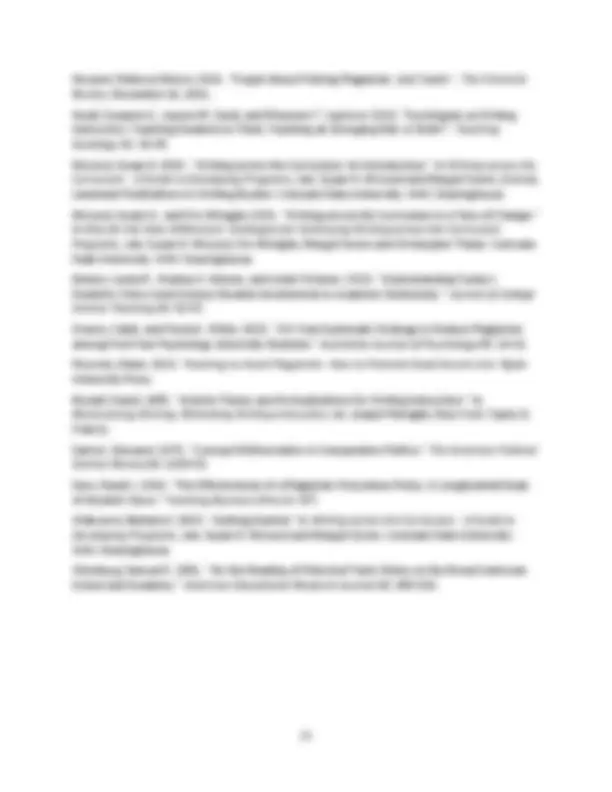
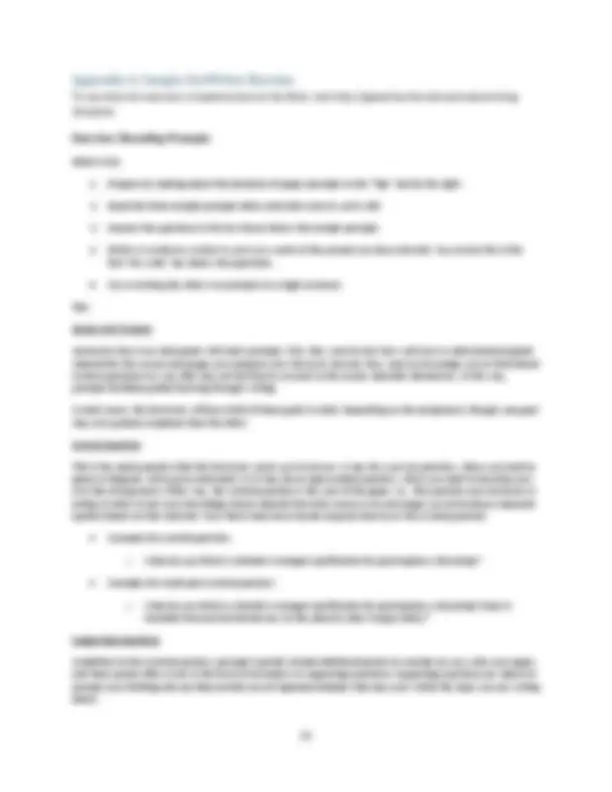
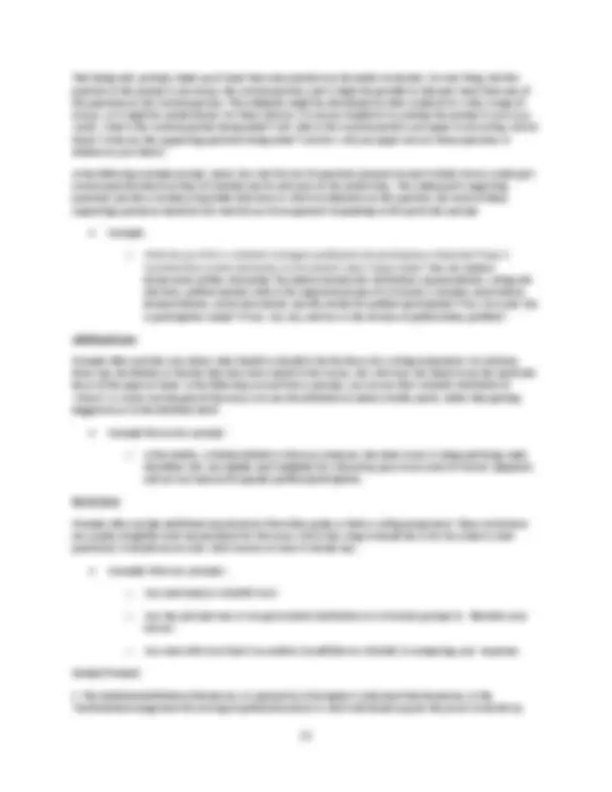
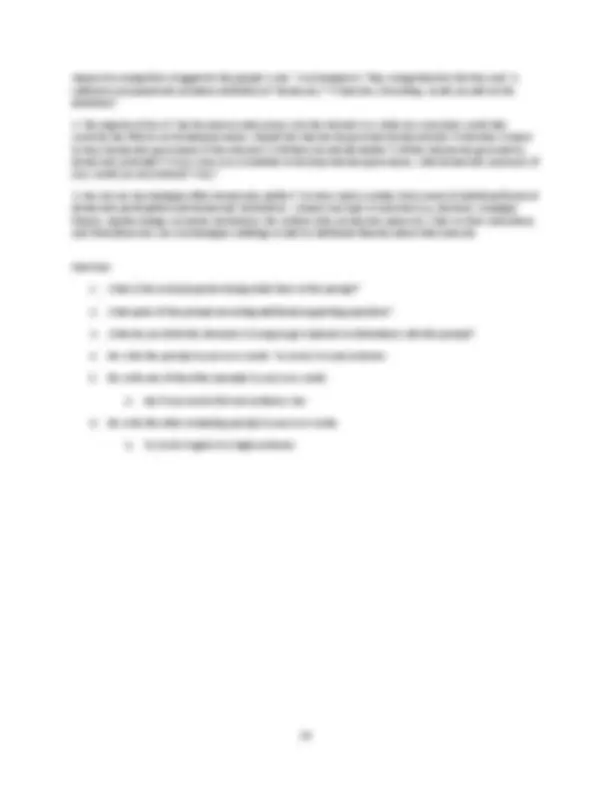
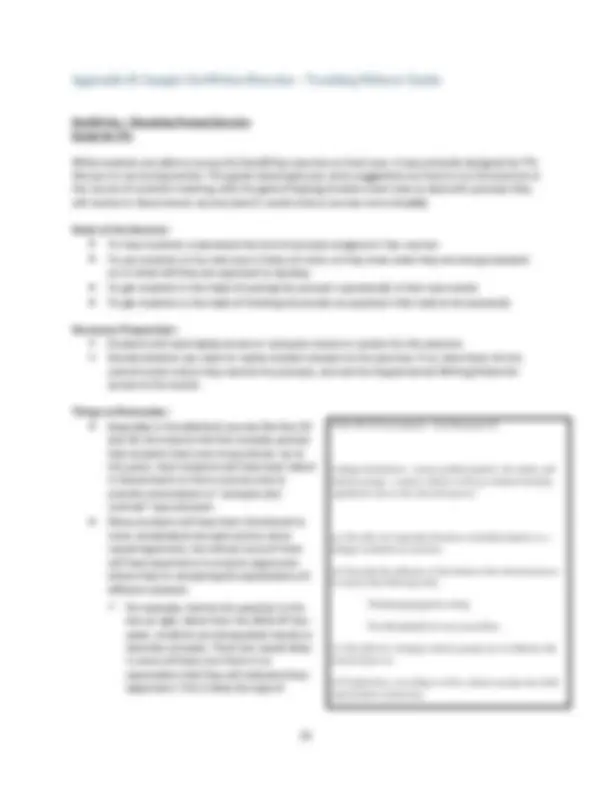
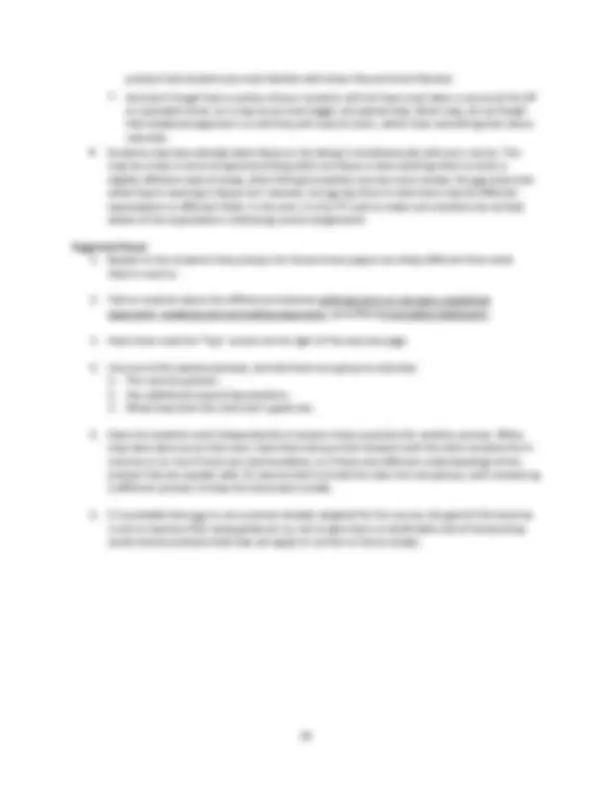


Study with the several resources on Docsity

Earn points by helping other students or get them with a premium plan


Prepare for your exams
Study with the several resources on Docsity

Earn points to download
Earn points by helping other students or get them with a premium plan
Community
Ask the community for help and clear up your study doubts
Discover the best universities in your country according to Docsity users
Free resources
Download our free guides on studying techniques, anxiety management strategies, and thesis advice from Docsity tutors
The challenges of teaching writing within specific disciplines, including the cost and time required, the need to teach community norms, and the importance of addressing plagiarism and academic integrity. It also introduces the concept of Writing Across the Curriculum (WAC) and its goals. Students may struggle to engage with academic conversations and properly cite sources, leading to potential plagiarism. The document suggests strategies for instructors to help students develop proper writing skills and avoid plagiarism.
What you will learn
Typology: Summaries
1 / 26

This page cannot be seen from the preview
Don't miss anything!



















Colin M. Brown George Soroka
APSA Teaching and Learning Conference, February 2017: Long Beach, Calif.
Teaching discipline-specific writing skills and academic integrity as it pertains to the norms of a given academic field is a particularly important task, but not one that individual political science (or other) departments are usually able to devote a large amount of time to. Instead, these are often seen as skills that will be taught by freshman writing programs, English departments…or whoever else’s job it is at the university. In those cases where writing is seen as a focus for the disciplines, interventions can be costly and time-consuming for faculty, graduate students and administrators. In this paper, we discuss the ongoing attempts to develop a tool ( GovWrites ) for teaching writing in Harvard’s Department of Government as a way to use a modular approach to teaching tools that lower the cost and increase the flexibility of their implementation. As the initial project is completed, we look to ways to test the effectiveness of the interventions and improve them in future models. GovWrites is a key component of a larger, multi-modal instructional initiative being developed by the Undergraduate Program Office of Harvard’s Government Department, one which also includes the GovTeaches project platform (the latter geared towards graduate teaching fellows and faculty and not available to students). The two together may be thought of as outward- and inward-facing sides of the same pedagogical implementation. The present paper, however, focuses exclusively on GovWrites , which represents the foundational, student- oriented element of this overall initiative. While GovWrites achieves its most tangible form as a website (http://govwrites.fas.harvard.edu/), in its entirety it is a systematic and modular approach to
thinking about discipline-based writing conventions and how to effectively convey them, and their associated skill-sets, to undergraduates.. The primary reason for teaching writing and academic integrity through a modular approach, which is central to the project’s vision, comes from a number of difficulties encountered in trying to teach these skills within a specific discipline. First, while effective models of teaching writing have been created in a number of universities through Writing Across the Curriculum programs, these programs are costly and require a high level of faculty involvement, which many departments cannot depend on due to their faculty’s already numerous time constraints. Second, teaching writing within a specific discipline requires the ability to teach that community’s norms at an early stage of a student’s writing development; without exposure to some form of political science argument, students often make incorrect or inappropriate skills transfers from other courses, even or perhaps especially when given expository writing instruction. Lastly, while more interventions to reduce plagiarism and academic dishonesty have been introduced in recent years, students are generally underexposed to the norms of academic integrity, especially in their field and especially after leaving their introductory writing courses. Below we briefly review the dominant ways in which writing and academic integrity are taught in American colleges and universities, as well as the literature assessing these approaches. We then describe the origins of this specific project and the features which emerged. The final part of this paper describes the GovWrites tool in greater detail, along with addressing its modular implementation in practice. We conclude by reflecting on ways in which to refine the tool and how to measure its effectiveness, which represents the next stage of this ongoing project.
Most students in college encounter analytic writing in a general first-year composition or expository writing course, which they are usually taking simultaneously with those courses that first expose them to writing within specific disciplines. These programs exist at the vast majority of US colleges and universities; enough to support more than 70 PhD programs to train instructors (Consortium of Doctoral Programs in Rhetoric and Composition). However, while
over the course of a student’s progress in college and regardless of the academic concentration they pursue. WAC curricula encourage departments to “scaffold” their curriculum towards specific goals upon graduation, such as senior theses or capstone projects, with intermediate writing projects and genre-specific instruction in the meantime. This holistic approach to writing at a university is centered on getting a lasting dialogue set up among faculty, so that the model is seen as an ongoing philosophy rather than a “training program” (Walvoord 2000). As disciplinary models change and as new types of programs, such as service learning or interdisciplinary initiatives are introduced, the structure of any given WAC initiative needs to adapt with it. Barbara Walvoord (2000) points out that while a loosely organized model is resilient, the introduction of such a program can be difficult and spur faculty resistance. In order to sustain the WAC model, departments and universities alongside many individual faculty must invest a high level of resources, making it an effective but costly solution in the end.
Writing instruction is seen as a fundamental part of the higher education process, and it is usually seen as something complementary to the process of liberal education, rather than a specific skill valuable primarily in its own right. The importance of writing to developing high- level thinking skills, such as (per Bloom 1956) synthesis and evaluation of materials is often cited as a justification for writing instruction. Moreover, effective writing has to do double duty: it is a learning aid and a communication tool at the same time. As John Bean (2011) puts it, “Writing is a process of doing critical thinking and a product that communicates the results of critical thinking” (p.4). What this means in practice is less clear, however intuitive the idea, and WAC curriculum developers have worked to maintain at least a theoretical distinction between the two goals. On the one hand, the use of writing as a tool for the learner should emphasize its value in “knowledge transformation,” (McLeod 2000, p.3) i.e., that it may not be helpful for fact retention but that has value in discovering new ways of applying or transferring knowledge from one task to another. This approach, focused on the benefits of writing to a students’
understanding, is often seen as the core principle animating WAC (McLeod and Miraglia 2001). The actual effectiveness of these “writing-to-learn” exercises seems to be mixed and may rely on interacting factors such as metacognitive tasks assigned alongside them (Bangert-Drowns, et al. 2004) or the receipt of sustained feedback on the assignments (Fry and Villagomez 2012), but it is at least a stepping-off point to conversations about ways of thinking On the other hand, writing tools can be used as a way of teaching how to write within a particular discipline. This process, described more broadly as entering a “discourse community,” is seen as useful both from the practical perspective of being able to effectively contribute to an academic field, but also as a way to teach “form[s] of social behavior in the academic community,” (McLeod 2000, p.3). The teaching of specific genres is not without controversy in composition studies,^2 as explicit modeling can be seen as a way of forcing conformity to any existing weaknesses or ideologies within a given discourse community (Freedman 1993). However, it is a way for instructors to address or to teach the eventual rhetorical purpose of any writing (Devitt 2004, p. 213), in a way that may be impossible to do without some explicit reference to the genre being used. In any particular genre, students generally show a reluctance to use writing as a way of entering into academic conversations. One reason for this is that in any form of summative assessment, students will have incentives to think of their writing as a way to demonstrate the knowledge they’ve acquired, not as a way to engage further with the material (Greene 1993, p. 60; Beaufort 2007, p. 38). Unless the ability to engage with other readings as an academic peer is expressly made part of the course’s requirements, students will be more inclined to use writing assignments as a vessel to reflect the content knowledge they have acquired without drawing connections between ideas. Another problem that students encounter is the feeling that there is nothing left to say; the critics have already said it all (Gaipa 2004). As our students have put it, “who am I to criticize Theda Skocpol? She literally wrote the book on this.”
(^2) See Devitt (2004) for an overview of the arguments
processes necessary for analysis a specific discipline or in teaching the norms of a discourse community, however, faculty are indeed uniquely well-placed to convey and model writing styles, and to identify the kind of cognitive analyses necessary to argue within a specific discipline (Hudd, et al. 2013, Dinitz and Harrington 2014)
One especially important aspect of teaching writing that is often left out of formal curricular design is plagiarism. Student plagiarism is seen as a serious offense, and one that can/should carry significant penalties. For example, at the authors’ university, the plagiarism policy reads:
All homework assignments, projects, lab reports, papers, and examinations submitted to a course are expected to be the student’s own work. Students should always take great care to distinguish their own ideas and knowledge from information derived from sources. The term “sources” includes not only primary and secondary material published in print or online, but also information and opinions gained directly from other people. The responsibility for learning the proper forms of citation lies with the individual student. Quotations must be placed properly within quotation marks and must be cited fully. In addition, all paraphrased material must be acknowledged completely. Whenever ideas or facts are derived from a student’s reading and research or from a student’s own writings, the sources must be indicated… Students who, for whatever reason, submit work either not their own or without clear attribution to its sources will be subject to disciplinary action, and ordinarily required to withdraw from the College.^4
It is important to note that not only are there strict penalties for breach of the policy, but the responsibility for knowing how to avoid plagiarism is left entirely up to the student. Yet there is considerable evidence that students have difficulty understanding plagiarism policies at universities, and that large numbers of them may never have engaged directly with the policy beyond it being discussed at early orientation events (Nelson, et al. 2013, Gullifer and Tyson 2014). Not only do students have trouble understanding the policies, but it is not always clear that the faculty who have to apply and
(^4) http://static.fas.harvard.edu/registrar/ugrad_handbook/current/chapter2/plagiarism.html
judge plagiarism standards always fully understand them, either (Gullifer and Tyson 2014; see also below for the challenges the authors faced in their department). Faculty may also have understandings that are misaligned with a university’s goals, or may feel that a university’s policy is unsupportive of their own goals as academics (Sunderland-Smith 2008). Students may also feel that the university or administration views plagiarism more harshly or in more moral terms than students themselves perceive, leading to a sense of fear that keeps students far away from potential plagiarism by not engaging with the kind of synthesis expected in academic work (Gullifer and Tyson 2010). With increasing access to electronic resources, even those students who intend to abide by plagiarism and citation policies may have more trouble intuiting the way that electronic sources are supposed to be cited or may not see them as having the same authoritative weight as paper texts (Pecorari 2013).^5 In general, students may perceive plagiarism as bad, but it is unclear that there is a mechanism by which simply having strict, unambiguous policies written down somewhere visible to students is sufficient. A large number of college students will enter disciplinary courses without significant practice in proper citation skills, either because they have not had significant writing experiences or because they have received their training in genres of writing that do not require the same type of writing skills (Pecorari 2013, p.36). In order to have students understand the reasons for avoiding plagiarism, and to be able to transfer skills across disciplines, it is likely necessary that directly teaching about plagiarism is necessary. A number of interventions have been tested, and while the size of the effects vary there seems to be a consistent finding that direct teaching of why plagiarism matters and how to avoid it is correlated with reduced instances of plagiarized student submissions. This may be through increased conceptual understanding of what plagiarism is—or isn’t (Belter and du Pré 2009), through attitude change (Owens and White 2013), or simply by greater awareness of what the penalties for plagiarism are (Sims 2002, Burgess-Proctor, et al. 2014). Another approach that has been advocated is the use of assignment design to prevent opportunities for plagiarism or make plagiarism more easily evident (Heckler, et al. 2013), or,
(^5) Pecorari notes also that faculty may themselves have ambiguous views on the relative authority of web and/or multi-authored sources.
none is “correct” in a universal sense. But without explicit attention brought to this, students who are successful in applying one style of citation may incorrectly transfer these skills in ways that cause them to be overly cautious in their citation, or worse, may lead to unintentional plagiarism.
The GovWrites project eventually uncovered or ran into many of these pitfalls of earlier attempts to look at writing in the disciplines, but it was originally developed as an immediate intervention to a specific problem. The genesis of this project dates to the fall of 2013 and conversations that took place between the Department’s Director and Assistant Director of Undergraduate Studies. The impetus for them was the well-publicized cheating scandal that shook Harvard College beginning in May 2012. Initially, the Undergraduate Program Office sought to be proactive specifically in addressing issues of academic integrity, it having become obvious that many students were ill-equipped to cogently articulate the underlying principles of ethical scholarly behavior (and the reasons for them), or to effectively differentiate between permissible and impermissible conduct in real-life examples. The latter realization was particularly vexing; while blatant plagiarism (e.g., copying entire sentences or paragraphs from a published source without attribution) is better understood, cases of alleged misconduct referred to the Honor Council for adjudication are typically not so cut-and-dried. Instead, after conducting a preliminary review, we discovered that most violations of academic integrity on written assignments resulted not from overt dishonesty, but rather poor work practices and time management. Among these were “cryptomnesia” (see Pecorari 2013): cutting and pasting a quote into a paper without immediately citing it and later not being able to determine where it originated from), as well as genuine confusion over how to deal with more complicated issues and various “gray” areas (e.g., what constitutes effective paraphrasing; is it possible to self-plagiarize?).^6 The latter was abetted by the absence of clear
(^6) Our Honor Council representative recently estimated that in the last several years, of all the academic dishonesty cases brought against students involving essays or research papers, around 60-70% would fall into the category of “unintentional” dishonesty, meaning the student either did not realize what she was doing was wrong, or was not sure how to proceed and found ways to self-justify taking the “easier” route.
departmental guidelines beyond a simple reiteration of generic University-wide injunctions against dishonesty. Without concrete illustrations and examples, as well as differing expectations concerning collaboration across various disciplines, these were of little practical effect, with many of our students uncritically importing accepted practices from the natural sciences (where group projects are the norm) and applying them to their social science courses. Finally, even tenured faculty in our department, to say nothing of the less experienced teaching fellows, were frequently signaling unclear or contradictory expectations to undergraduates regarding issues such as sharing reading notes, discussing assignments with others, and using outside editors (be they a family member or a professional service). In short, we found our students were often ill-equipped not only to navigate the sometimes admittedly perplexing terrain of academic integrity, but also to determine when they had strayed beyond its boundaries in the first place. As in our department the evaluative component of virtually every course involves substantive writing, whether in the form of in-class bluebook exams, take-home response essays, or longer research papers, it soon became clear to us that it was impossible to divorce any discipline-specific discussion of academic integrity from wider conversations about the conventions and expectations of writing in the social sciences. Indeed, the more we examined the issue, the more it became apparent that a synthetic, cross-disciplinary approach was warranted. Not only did we come to the conclusion that promoting academic integrity is part and parcel of teaching effective discipline-based writing, but we also came to strongly suspect, as the literature at least partially bears out, that becoming an effective writer makes you a better reader, and vice versa, there existing an innate connection between the consumption and production of knowledge. But if learning to write effectively (e.g., by understanding what evidence is central to making an argument versus what is peripheral) also makes one better able to quickly determine the main points underpinning an assigned text, the promotion of such “virtuous cognitive cycles” would suggest that incorporating the teaching of writing directly into introductory-level political science courses (rather than teaching it as a stand-alone topic, often
By evidentiary, we mean teaching students how to appropriately acquire and analyze evidence in making an argument, including the need to adequately consider counterfactuals and disconfirming cases, when appropriate. By presentational, we mean how their thinking is presented, both logically and stylistically. No matter how strong an argument is overall, if the thesis is buried or obscured by mountains of tangential points, it will not be as effective as a more succinct, focused effort. Similarly, if a paper is marred by awkward phrasing and grammatical issues, it will not be as capable of conveying information as one that is not. Unclear writing will often, if not always, be a symptom of unclear thinking or understanding of the course content. And finally, the ethical component is exactly what it sounds like: we put a stress on academic integrity, which means not just caring that words, once they appear on a page, are properly attributed, but also caring about the overall process students go through as they research and write their papers. This means also focusing on subjects such as good study habits and effective note-taking, and learning to approach the adaptation of ideas as a member of an academic discourse community. Yet once the conceptual basis for this project was refined, we were still faced with the task of somehow implementing it. In a series of conversations with people from the Harvard College Writing Program.^8 We learned that they had recently constructed a website called HarvardWrites (used in Harvard’s expository writing classes), and decided that while we would significantly adapt the content, we would explicitly model our efforts visually after the earlier site. The reasons for doing so are several. First, both sides felt very strongly that it was important to think of teaching student writing as an iterative, multi-stage process. Therefore, we felt replicating the look of HarvardWrites in GovWrites innately conveyed the idea that we were directly building on what students had earlier learned. We have since explicitly communicated to students: “the expository writing classes teach you how to write at a college level; we take the next step and refine those skills to discipline-specific writing.” Second, we were also eager to franchise the idea to other departments in the College^9 and believed that
(^8) In particular, we are indebted to Dr. Tom Jehn, the Sosland Director of the Harvard College Writing Program, and Dr. Jonah Johnson, then a preceptor in it. 9 Both in a more practical effort to secure support from the University administration and a more pedagogical effort to increase the types of writing assignment we were aware of and could address.
keeping a similar look across resulting sites would not only make sense intuitively, but also create economies of scale by allowing a basic web template, once designed, to be affordably cloned and customized (there is already an AnthroWrites , and other departments are currently developing analogues). Finally, we felt that the HarvardWrites site, which features curated videos, sample pieces of writing, and interactive, step-by-step writing guides for students, nicely encompassed our vision of a modular, multi-modal tool. This would allow it to be both selectively implemented (e.g., faculty could choose to project videos of departmental faculty speaking about academic integrity during a class meeting in a lecture hall, but not necessarily require students to work through the online writing assignments, depending on their needs) and selectively expanded (e.g., we are in the process of incorporating interviews we conducted with freshman concerning how their writing developed over the course of completing two papers for Gov 20, which will be available on the website and used as a real-world example to model in-person writing workshops). Consequently, GovWrites was launched in the fall of 2015, concurrent with the co- authors of this paper teaching Gov 20. The website was initially used in TF-led sections, in our associated in-person writing workshops, and by students individually. It has since been rolled out throughout the department to a highly positive response.
Below is a screenshot of the landing page for GovWrites (govwrites.fas.harvard.edu).
hours of video shot for each of the four faculty members depicted. Once edited, 3-4 minute videos on each topic were available. The videos themselves may be used as stand-alone presentations to introduce concepts and spur discussion, as in a classroom setting. They also introduce the written information and practice exercises that follow them. Our goal is eventually to be able to annotate examples of writing both asynchronously via the GovWrites site and in real-time, using dynamic input from students via an app or Learning Management System (LMS), which would allow the workshop instructor to adapt to the ways in which students are perceiving information with almost no delay. Initial implementation of these tools using Learning Catalytics has allowed workshop instructors to allow students to respond in real-time to sample writing prompts, display the data, and have students critique and improve their responses via paired learning or in group- wide discussion. The point, however, is that GovWrites can be used in a number of settings, whether as part of a lecture (where the “defining the discipline” video may be shown to introduce freshmen to what political science is and the topics it covers), in a writing workshop, or on a student’s own in a dorm room (if a student wants to refresh their memory about a particular concept). Below the video are various written exercises, tips, and samples of writing. A critical component of this is that we teach by utilizing concrete examples. For instance, under “Writing in Government” we discuss how to “decode” professors’ prompts (i.e., questions students are asked to answer in an essay) and lead them through several exercises in doing so, which can either be completed independently or in a workshop setting. We eventually will have videos of students discussing their iterative attempts at this process, filmed before the first paper was due for Gov 20 and then after the second was submitted (the reported differences thus far have been impressive, and we believe this information will serve as an important “short-cut” through which to instruct future students). However, it is also worth noting that “teaching teaches the teacher.” Before we embarked on this exercise, we did not adequately appreciate the difficulty many students had in “decoding” complicated or vague prompts, particularly if they were “nested” (e.g., had multiple sub-questions within them that had to be prioritized or
sorted in compiling a response).^11 Similarly, under the heading “working with integrity” we do not just admonish students not to plagiarize, but walk them through some more complicated examples of what plagiarism may look like. We eventually plan on having an interactive “academic integrity quiz” here as well, where students will be presented with real-life scenarios in which they will have to decide what is appropriate behavior and what is not. The quiz will adapt to the level of the student in question (those who get answers right will be presented with progressively more difficult scenarios, while those that flounder will have concepts repeated in various guises). The critical benefits here are that reinforcement will be immediate and specific—students will be given instant feedback on their choices so that they can understand why certain scenarios violate the College Honor Code while others do not, and will do so using examples that let them practice the norms of a specific discipline. Finally, the thematic headers were chosen to work in unison with one another, to create a dynamic “narrative arc” tying together disciplinary expectations, translating these to expectations for writing, stressing proper and improper forms of collaboration and finally ending by emphasizing that integrity underlies all scholarly endeavor. Again, it does this by noting concrete reasons why integrity is needed in the discipline’s academic endeavors—for example, stressing the ability to reproduce published results. These factors all tie back to specific project goals identified in the introduction to this paper.
What exactly do we mean by the term “modularity”? At the most basic level we mean that it is possible to take specific aspects of the GovWrites platform and use them independently in teaching as needed for a specific course or as desired by a specific instructor. For example, the same exercises may be used in both large-group and one-on-one formats, and tools and exercises can easily be populated with prompts specific to a given course. In addition, the modular structure developed in political science makes it easy to adapt, swap out, and add or delete modules as appropriate for a specific discipline’s writing needs.
(^11) An example of how this exercise is implemented on the Web site, along with an instructional guide given to teaching fellows, can be seen in the following appendix.
implementation of this website was designed in OpenScholar, but we have begun transitioning to WordPress for the added flexibility it affords in this regard.) Meanwhile, we are able to build- out content online to allow the tool to evolve along with departmental needs, and the most ambitious instructors are even able to custom-populate text boxes and assignments, allowing them to have very precise control over which skills are being taught, when they are taught, and how they are taught. In short, we have sought to develop a tool useful to entire department as a turn-key system, while also allowing faculty who chose to do so to emphasize writing directly in their courses while lowering the start-up costs of doing so.
The next stage of this project will involve actually measuring the impact specific pedagogical interventions (e.g., writing workshops on specific topics, or using a volunteered paper for online peer-review) have on student outcomes. While we have not yet gone through the IRB process, we hope to be able to conduct randomized studies in our largest classes this coming fall term to determine the relative effectiveness of various ways of utilizing GovWrites in the teaching of effective disciplinary writing. The early stages of the GovWrites process were designed to leverage available resources and fill immediate needs, and led to the understanding of the advantages modularity would have for the implementing departments. At the next stage, GovWrites will provide opportunities to test the effectiveness of specific interventions, and it is at this stage that guidance for collecting and testing is needed.
Applebee, Arthur N. 1984. Contexts for Learning to Write : Studies of Secondary School Instruction. Edited by Judith A. Langer. Norwood, N.J. ———. 1981. Writing in the Secondary School : English and the Content Areas. Edited by Anne Auten and Fran Lehr. Urbana, Ill. Bangert-Drowns, Robert L., Marlene M. Hurley, and Barbara Wilkinson. 2004. "The Effects of School-Based Writing-to-Learn Interventions on Academic Achievement: A Meta-Analysis." Review of Educational Research 74: 29-58. Barnes, Douglas R. 1976. From Communication to Curriculum. Harmondsworth.
Beaufort, Anne. 2007. College Writing and Beyond : A New Framework for University Writing Instruction. Logan, UT. Belter, Ronald W., and Athena du Pré. 2009. "A Strategy to Reduce Plagiarism in an Undergraduate Course." Teaching of Psychology 36: 257-61. Bloom, Benjamin S. 1956. Taxonomy of Educational Objectives: The Classification of Educational Goals. Edited by Benjamin S. Bloom. 1st ed.] ed. New York. Burgess-Proctor, Amanda, Graham Cassano, Dennis J. Condron, Heidi A. Lyons, and George Sanders. 2014. "A Collective Effort to Improve Sociology Students’ Writing Skills." Teaching Sociology 42: 130-39. Carter, Michael. 2007. "Ways of Knowing, Doing, and Writing in the Disciplines." College Composition and Communication 58: 385-418. Consortium of Doctoral Programs in Rhetoric and Composition. https://ccccdoctoralconsortium.org/about/. Council of Writing Program Administrators. "Defining and Avoiding Plagiarism: The Wpa Statement on Best Practices." http://www.wpacouncil.org/node/9. Devitt, Amy J. 2004. Writing Genres. Carbondale. Dinitz, Sue, and Susanmarie Harrington. 2014. "The Role of Disciplinary Expertise in Shaping Writing Tutorials." The Writing Center Journal 33: 73-98. Franklin, Daniel, Joseph Weinberg, and Jason Reifler. 2014. "Teaching Writing and Critical Thinking in Large Political Science Classes." Journal of Political Science Education 10: 155-65. Freedman, Aviva. 1993. "Show and Tell? The Role of Explicit Teaching in the Learning of New Genres." Research in the Teaching of English 27: 222-51. Fry, Sara Winstead, and Amanda Villagomez. 2012. "Writing to Learn: Benefits and Limitations." College Teaching 60: 170-75. Gaipa, Mark. 2004. "Breaking into the Conversation: How Students Can Acquire Authority for Their Writing." Pedagogy 4: 419-37. Goertz, Gary. 2006. Social Science Concepts : A User's Guide. Princeton. Greene, Stuart. 1993. "The Role of Task in the Development of Academic Thinking through Reading and Writing in a College History Course." Research in the Teaching of English 27: 46-75. Gullifer, J. M., and G. A. Tyson. 2014. "Who Has Read the Policy on Plagiarism? Unpacking Students' Understanding of Plagiarism." Studies in Higher Education 39: 1202-18. Gullifer, Judith, and Graham A. Tyson. 2010. "Exploring University Students' Perceptions of Plagiarism: A Focus Group Study." Studies in Higher Education 35: 463-81. Heckler, Nina C., David R. Forde, and C. Hobson Bryan. 2013. "Using Writing Assignment Designs to Mitigate Plagiarism." Teaching Sociology 41: 94-105.